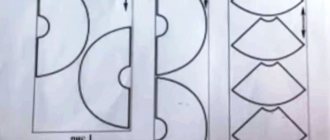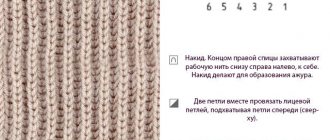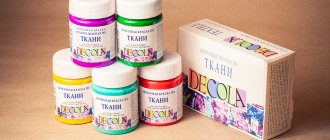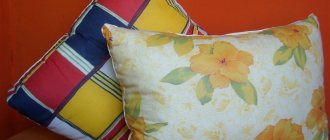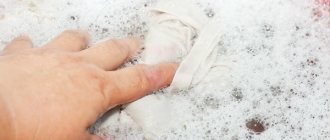Unfortunately, the original bright color of clothing cannot be preserved forever, even with the help of modern washing powders and special care products. Sooner or later, a moment comes when, looking at your favorite thing, you realize that it has already faded hopelessly and it’s time to do something. But you don’t even want to throw away a faded blouse or faded T-shirt. In fact, there are many really useful and effective tips on how to restore the color of clothes.
General recommendations
As a rule, every new item has a label that says how the item should be washed (suitable water temperature, whether it can be washed and spun in a washing machine, etc.). Following these instructions will help maintain the beautiful appearance of the product for a long time.
Before washing, items should be separated by color. Under no circumstances should contrasting items be washed together - one of the items may fade and ruin all the laundry.
Do not forget that it is necessary to correctly dose the appropriate detergents. For colored products, powders marked color are usually used. This inscription indicates that this detergent is suitable specifically for colored items.
Any items must be rinsed thoroughly, especially for colored and dark fabrics. For this purpose, modern washing machines have an additional rinse function.
However, even if such recommendations are followed, your favorite clothes often lose their former brightness of color. This can be facilitated by:
- Numerous washings and rubbing of fabrics.
- Exposure to sunlight.
- Long-term storage in a closet.
Proper care
In addition to the basic rules of fabric care, you should know something else:
- Don’t wear things out, change your look more often. The need for frequent, sometimes daily washing quickly destroys the color of the product.
- Avoid “Whiteness” and other chlorine-containing products when cleaning black and colored items. For white, such stain removers are acceptable, but as a last resort, and only for natural cotton and linen.
- If an item sits in the closet for a long time, it may also lose color. Don't forget about bright sweaters and T-shirts.
- For delicate fabrics with special shades it is very difficult to choose a dyeing method, but dry cleaning specialists will help you.
And if the item is hopelessly faded or faded, and not a single method has worked, then there is a reason to please yourself with shopping. Just next time, pay more attention to the information on the item’s tag and proper care.
Ammonia
The use of this substance is one of the most reliable and proven ways to restore the presentable appearance of clothes. It is usually diluted at the rate of 20 ml per 1 liter of water. Faded wool or cotton items are placed in such a solution at room temperature and left for 15 minutes.
If the product needs to be bleached, add a little bleach to the solution. To achieve crystal whiteness of things, they are boiled in this mixture for 30-40 minutes. However, you can boil products if there are no restrictions on their labels regarding the water temperature during washing.
Soft bleaches from chemical production
Today, manufacturers offer a lot of special products that can restore faded clothes. As a rule, they are used when washing clothes. However, before using them, you must carefully study the attached instructions, otherwise the damaged items may be completely damaged.
If home methods do not help, and gels and powders for black, for example “Laska”, are powerless, then try re-dying. There are many special compounds for textiles in household chemical stores. They have a number of advantages:
- The substances that make up the dyes do not remain in the fabric fibers after use, and therefore rarely cause an allergic reaction;
- The paints are suitable for restoring the color of any material, both wool and silk. It doesn’t matter what caused the product to fade, the result will definitely please you. The price of such funds is affordable;
- To “save” a thing, one coloring is enough. At the same time, you will be 100% sure that your favorite jeans or dress will become beautiful as before.
Textile paint is easy to use; washing with a special chemical is usually sufficient. For the procedure to be successful, follow these rules:
- When buying paint, choose high-quality and more expensive paint so as not to spoil the textiles.
- Read and follow the instructions carefully.
- Choose a product based on the type of fabric.
- Work in rubber gloves.
- Dilute the composition in a steel or enamel container.
If several items need dyeing, process them one at a time. If you do not follow the recommendations, you will get an uneven color with spots and streaks.
The most popular dyes include:
- Dylon is a powder that is used for natural materials. Coloring occurs during the washing process;
- Technochem is a universal preparation for any fabric. Designed for hand washing and machine washing;
- DKT-38 – dyes natural, silk, mixed fabrics and synthetics;
- DKT-37 – intended for polyamide material, wool and mixed types of fabrics;
- Simplicol – suitable for natural fabrics.
High-quality dyes do not violate the structure of products and are easy to apply. Manufacturers claim that such chemicals are not dangerous to human health. Be sure to follow the instructions to get a good result and not harm your clothes. If all else fails or you don’t want to deal with chemicals, take the item to a dry cleaner, where specialists will return it to its original color without harming it.
Onion peel
Our great-grandfathers knew how to restore the color of clothes using onion peels. This effective method works great on brown and green clothing colors. To obtain the necessary remedy, you need to boil ordinary onion peels in water for a long time. The result is a strong solution that will give faded and faded materials golden brown or greenish hues.
However, before doing this, you need to check on a small piece of fabric from the wrong side to see if the tone will change. The required color can be obtained by changing the concentration of the onion solution.
Means to tint textiles
Securing or brightening the fabric is sometimes not enough. If there is too little pigment, all that remains is to dye the fabric.
Store products
Let's turn to hardware stores: what do they offer in order to restore the brightness of colored items?
Synthetic dyes for fabrics
These products are recommended for dyeing faded fabrics, as well as for creative experiments. Remember how in the 2000s everyone boiled their jeans in a dye solution?
According to the instructions, dilute the powder with the dye and hold the item until completely dyed. Be careful to buy a dye that matches the fabric of the product.
Bleaches
Gentle oxygen bleaches, which also work in cold water, help restore the whiteness of any fabric.
Home Recipes
Some home remedies have coloring properties. More often, clothes have to be cleaned of such products. But this time they will become our assistants. So, how to dye clothes a particular color?
Black
Use mascara or black ink. When soaking in saline solution, add a couple of drops of the substance and stir well. Don't forget to rinse the item.
This solution also strengthens and renews the black color: pour 20 g of tobacco into 1 liter of hot water and let it brew for 30 minutes. Treat the fabrics with the solution and wash.
Red and its shades
To give your pants and T-shirts a red color, rinse them in a solution of vinegar and baking soda. For 1 liter of water - 1 tbsp. l. each product.
Blue or cyan
Jeans and other items with a blue tint can be restored with ordinary blue. The saturation of the solution depends on the desired result and the original color of the jeans.
After dyeing, rinse the fabrics in a soda solution to enhance the brightness.
Beige, cream and brown
Black and green tea are some of the toughest stains to remove. Tannins fix the color on the fabric, and you have to resort to bleaches.
Brew strong black tea. Soak the fabrics in the solution or sponge them and let them dry before washing. The stronger the tea, the darker the shade.
Steaming onion peels, ground coffee, and nut shells will provide a similar result.
Yellow or orange
Save the orange peel, either fresh or dried will do. Steam it with boiling water and let it brew to get a rich orange drink. Apply evenly to clothing.
Green
You already guessed that a bottle of brilliant green, popularly known as brilliant green, is responsible for restoring the green color. Prepare a solution and soak clothes in it for 10-15 minutes, and then rinse well. Remember to use gloves to avoid accidentally staining your skin and a vinegar or saline solution to set the color.
The joy of your favorite shades
Our mothers and grandmothers remember very well how to restore the color of clothes at home. Washing and soaking with bleach is an effective way to restore and preserve white items. Hydrogen peroxide or a weak solution of potassium permanganate will also help to refresh the whiteness. Using regular laundry soap also helps maintain cleanliness and freshness.
Since ancient times, to restore terracotta, cream and beige shades, products have been rinsed for several minutes in a weak tea solution. This method is also successfully used to refresh the color of nylon stockings - the shade becomes deeper and more saturated.
Washing rules
It is known that there are rules for washing colored, black and white clothes. For some reason, many people neglect them, and then wonder how to return the black color to clothes or any other?
We suggest you familiarize yourself with How to remove mold from fabric: how to remove stains on clothes and shoes
To prevent the fabric from losing its visual characteristics when washing, you must follow its basic rules:
- Washing and ironing should be done at the temperature recommended on the label. Usually the manufacturer sews it from the inside to the product.
- Colored items should only be washed with a special detergent or powder intended for them.
- Before throwing wardrobe items into the washing machine, they must be turned inside out.
- Dark, denim and black fabrics should always be washed with dark detergent added to prevent them from losing their richness.
- White items should not be washed together with colored or dark clothing. She may shed. You should also use a special powder with bleaching properties, intended for the care of white things.
- Colored or black items should not be dried in direct sunlight.
- The machine wash cycle must correspond to the type of fabric.
The first rule to follow is to follow the care recommendations indicated on the label. Many fabrics require delicate handling, that is, gentle washing and low temperature when ironing products. You need to select a detergent based on the composition of the material. It is not always possible to use the same powder for washing natural and synthetic fabrics.
Fabrics containing wool should not be soaked, because the dye will be washed out, and the product will lose its shape. Woolen items should be washed with special products, preferably of a liquid consistency. Powders contain phosphates, which negatively affects not only the shades, but also the performance properties of fabrics.
Clothes may fade if items of different colors are loaded into the washing machine. White dresses, skirts, blouses, shirts should even be soaked separately from colored ones. In order to prevent changes in the shade of the fabric, sort the laundry not only by color, but also by composition - so that the washing conditions are the same.
Our grandmothers always rinsed their clothes with vinegar; this prevented the color from fading and helped neutralize the negative effects of synthetic detergents on the body.
Doing laundry is easy when you have a tag with a hint in front of your eyes.
Image is clickable
The fabric tag is sewn into the inner seams of the garment. It contains information about the composition of raw materials and care recommendations. Information is displayed with icons. Most of them are intuitive.
In order for the item to take its original shape, it must be properly dried and ironed.
- cotton and linen. They need to be ironed almost immediately after spinning, because... smoothing them out completely dry is a real challenge. Don't overdry. When hanging on ropes or hangers, straighten them well, this will also make ironing easier. Set your machine to anti-crease mode, if available. Avoid direct sunlight when drying to prevent the fabric from fading or fading;
- Dry synthetics, except acrylic, on hangers or ropes, carefully straightening them out. Avoid the sun to prevent things from fading. Ironing is usually not required, but if necessary, iron on the “silk” setting with a humidifier;
- wool, membrane, silk fabrics, knitwear, acrylic. Place the wet item on a horizontal surface on a thick cloth, straighten it thoroughly and dry at room temperature. Do not place near a radiator: fibers (especially wool) become brittle in dry, hot air. Silk can be dried on hangers;
- Iron wool, knitwear and acrylic lightly from the inside out through a damp, dampened cloth. If the ironing cloth is moistened with a vinegar solution, the wool will not have a shine. Do not iron membrane fabrics. Iron silk at low temperatures;
- Dry colored items only in the shade and inside out.
- Rinse blue and light blue items in a soda solution;
- Soak brown items in weak tea leaves (the result will differ from the original, but the color will come to life);
- soak yellow and orange fabrics in a decoction of orange peels;
- keep black and multi-colored things in a saline solution;
- Restore yellowed white items with special bleaches.
We invite you to familiarize yourself with the signs and superstitions associated with the money tree - why it falls, dies, blooms
Pink, peach colors and decorative threads
When rinsing such delicate flowers, you need to add a couple of tablespoons of ammonia to the water. Clothes embroidered with decorative threads should be soaked briefly in warm salt water before washing. To obtain the optimal concentration of the solution, you need to use two teaspoons of coarse table salt for every liter of liquid. After this, the product is washed in soapy water and rinsed thoroughly. As soon as the item is completely dry, it is carefully ironed from the wrong side.
Preparing for washing
The washing result depends to a large extent on the preparation of items for the process. In order not to end up with an unintelligible lump with stains instead of fresh things, you need to perform a number of simple manipulations before starting the machine.
Getting things ready
- duvet covers and pillowcases are washed inside out. Turn them inside out and clean out dirt stuck in the seams and corners of the products with a toothbrush;
- Turn out knitted and terry skirts, trousers, hosiery;
- on blouses and shirts, straighten the folded cuffs and collars for better washing;
- free curtains from removable fasteners: hooks, rings, etc.;
- fasten items with buttons, zippers, and hooks; unfasten items with buttons. Tie the laces and ribbons so they don’t get tangled;
- empty your pockets.
Sorting fabrics
- by color. Dark, light and colored items are washed separately. Some classify pastel fabrics and patterned products into separate categories. Fabrics that can fade also require an individual approach;
- according to the degree of contamination. Fabrics that require pre-washing or stain treatment are washed separately;
- according to temperature conditions. If possible, study the labels on items and wash fabrics that require the same temperatures in one wash. Do not mix silk and wool fabrics with cotton and linen;
- by texture. A hard, dense product can damage the thin fabric of underwear or, for example, curtains;
- according to the pile. Threads from terry towels may remain on the sheets;
- Velvet and plush products should not be washed. It's better to take it to the dry cleaner.
Let black stay black
Products in black or dark colors are very practical for daily wear. However, numerous washes have a negative effect on them - these shades fade a little and lose their former luster.
Brewing black tea or a tobacco solution will help preserve and restore the black color of clothes at home. Rinsing in salt water will help to refresh it a little and restore the depth of color. Products of dark colors can be tinted with special products sold in hardware stores. This method will perfectly help to even out the color if things are worn out in places.
Dye selection
If you need to repaint your clothes, it is better to buy paint in advance. In this case, the savings will be unnecessary - a cheap dye can give a completely unexpected result. Therefore, it is better to make a choice in favor of a well-known manufacturer. Dyes that are distinguished by their quality and effectiveness can be found in an art store. It is better to choose acrylic for dyeing fabric. It is better to pay attention to a wide range of colors. If the desired color is not found, you can mix several shades to achieve the desired result.
Before purchasing, you can consult with the seller, who will tell you about the dye, its properties and effectiveness. In addition to the paint manufacturer, the original color of the down jacket also matters. You can often find a table with the end result on the packaging of coloring products. But this rule only applies to white clothes. If you need to repaint a colored jacket, you need to buy paint a shade darker.
How to restore the blue color of clothes
Rinsing with ordinary table vinegar or baking soda will help to refresh and slightly restore the red and blue colors in clothes. Soda can also be added when washing blue clothes: just one dessert spoon per liter of water helps to return the clothes to their salable condition. The fact is that organic acids in small quantities help strengthen any bright shade and keep products looking fresh for a long time.
Many people advise using ammonia diluted in warm water. Blue and light blue items placed in such a solution will regain their lost brightness in just a couple of hours.
Faded dark things
Is your black T-shirt torn and a little faded? Don’t rush to throw it away, it will still help you out. She is the one who will tell you how to return the color to black things. If the fabric has the ability to give off color, it means it will help restore the beauty of another product.
Before washing a black dress, wrap it in an old, fadeable T-shirt. The T-shirt will fade again and will help restore the dress to its former brightness and elegance.
Vinegar
This method not only returns the color to black things, but helps to preserve it. However, it will also restore slightly faded products to their former beauty:
- Wash and rinse the item.
- For the final rinse, fill a bowl with cold water.
- Dissolve 2-3 tablespoons of vinegar.
- Soak the product and leave for half an hour.
- Rinse and dry the product.
Salt and soda
A great way to give dark clothes their original shine is to rinse in a salt-soda solution. The product must first be washed and rinsed a couple of times. To do this correctly:
- Pour cold water into a basin.
- Dissolve a pinch of salt and 1 tablespoon of soda.
- Soak the item for a few minutes, rinse and dry.
Important! You should not soak things for longer than half an hour.
Possible options for decorating a down jacket with your own hands
Needlewomen use many ways to update an old product. The most popular include:
- fur;
- special textile applications;
- additional zippers or buttons;
- brooches made of beads or rhinestones;
- various badges with symbols of popular brands, logos of favorite musical artists;
- decorative stripes.
You can also add a belt or small strap in a bright color scheme. In this case, it should be taken into account that the belt acts as an accessory. In this case, shoes and other accessories (handbag, scarf) should be chosen to match.
Before starting work, you should prepare all materials and tools. To work you will need:
- needle;
- threads to match the product;
- buttons or zipper;
- glue suitable for fabric;
- materials for decoration.
When everything is ready and the accessory has been selected, you can begin the technological process.
Fur inserts
Fur is the most optimal and affordable way to update an old product. There are many options. You can trim the hood line with a fur strip (photo). In your wardrobe you will probably find an extra fur collar from an old and unnecessary jacket. Many girls also add fur to their sleeve cuffs. If the down jacket is made without a hood, we trim the collar in the manner of a coat. This collar will protect your neck from cold air and keep you warm in cool weather.
Many collars have special loops for attaching fur. It is necessary to carefully sew small buttons, maintaining the distance between each other to accurately fit into the fastenings. In this case, the fur can be easily unfastened.
Reference! If you don’t have an extra fur insert in your wardrobe, you can purchase it in a specialized store or studio.
Applications
Textile appliqués give a lot of room for imagination and are easy to use. You just need to choose the appropriate pattern and its location. You can use two identical or different stickers by attaching them to the shelves or sleeves of the product.
There is a special adhesive layer for fastening. Peel off the film and attach the applique to the selected area of the down jacket. It is recommended to place something heavy on top (for example, an iron) so that the sticker “sticks” to the fabric more securely. By the way, this method can be used to repair damage to a down jacket: small holes, cuts or burn marks from cigarettes.
Important! The use of heat treatment with an iron should be avoided, as a hot platform will ruin the down jacket. Choose applications that are attached without a heating device.
Patches or badges
Patches are attached in the same way as appliqués. You can purchase them in specialized stores or make them to order according to an individual sketch. 3D style stripes are especially popular now. Using this decor you can also repair damaged fabric.
To decorate the down jacket, carefully peel off the protective film and attach the patch to the selected area. Down jackets with stripes on the back stand out. This could be some phrase in a foreign language, your favorite characters.
Advice! If the patches are used without an adhesive layer, we use a special glue for working with fabric.
Badges are also used instead of stripes. A product with wooden badges will especially stand out. However, there is one drawback to using such accessories: the needle leaves small holes in the fabric. If such a factor does not frighten the owner, you can attach several badges in the chest area. The modern market presents a large selection of small accessories: animals, cartoon characters, TV series, books or movies, fruits, vegetables or desserts, images of popular musical performers and other accessories. With such variety, every fashionista will find a suitable option for herself.
Beads or rhinestones
This option will help make the down jacket more feminine and sophisticated. Many needlewomen weave brooches on their own. If you do not have such skills, ready-made accessories can be purchased in specialized stores. In this case, the brooches already have a special needle for attaching to the fabric. You can also simply carefully sew it onto a selected area of the down jacket.
For a brighter version of the down jacket, rhinestones or pearls are used. On store shelves you can find decorative elements with a special adhesive layer or holes in order to carefully sew the pebble to the fabric. If both options are missing, you can attach the stone using glue.
The most successful option for decoration is to attach decorative elements in the area of the shoulder section with a slight transition to the center of the shelf. It is advisable to use rhinestones in different colors and sizes to make the down jacket brighter and more interesting. Before starting work, make an approximate location of the stones, and then proceed to fastening. If there is no adhesive layer, the rhinestones are carefully sewn on with threads to match the product.



